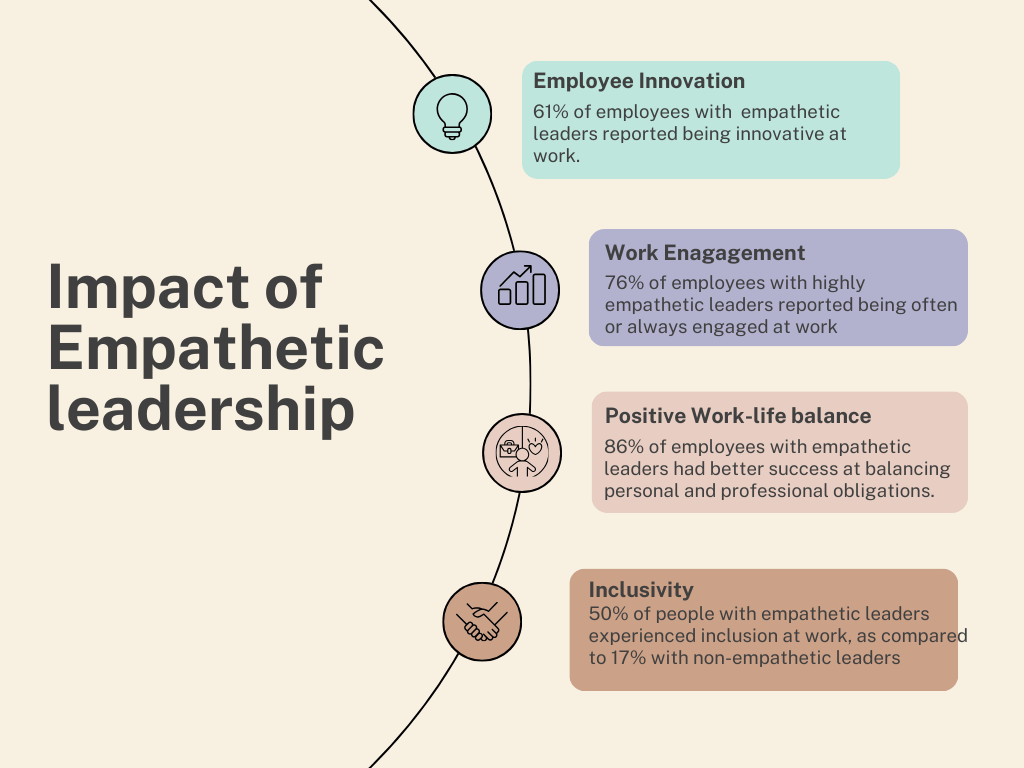The Power of Empathetic Leadership: Why It Matters

Imagine a world where leaders don’t just manage teams, but truly understand and connect with the people they lead.
Let’s talk about a leadership skill that is often overlooked – EMPATHY.
In today’s fast-paced and ever-changing work environment, leading with empathy has become an invaluable skill for effective leaders. But is empathy a “feel-good” element, a “nice-to-have” quality or does it have any business impact?
What’s being a leader truly like!
The real job of a leader is not about being in charge, it is about taking care of those in charge. One of the important things that are lacking in most of our companies is that they are not teaching us how to lead and leadership is a skill, like any other, it is a practicable, learnable skill.
At its core, leadership revolves around others, it involves inspiring people to exceed their own expectations and lead them in a direction that is compelling and inspiring.
Empathy – a skill like no other- can make a big difference when it comes to leadership. When employees do not get the leadership they deserve and need, that is when things go down. This disconnect can lead to a decline in performance and morale. What needs to be understood is that the individual success of an employee and the holistic success of a company are not mutually exclusive, but they go hand in hand.
This is why empathetic leadership is the need of the hour.
It is more than just a leadership style, it is a mindset that enables employees to be their very best selves, and this is supported by a study conducted by Microsoft.
Nearly 64 per cent of employees surveyed with empathetic leaders say that they are satisfied with their job and 83 per cent of them feel seen and valued. These numbers are twice as high as those achieved by non-empathetic leaders.
Understanding empathetic leadership
Empathetic leadership is a leadership style that helps leaders’ step into the shoes of their employees. It encourages leaders to understand their team members’ perspectives, emotions, and experiences. It involves genuine care for individuals, curiosity about their motivations, and the ability to connect with diverse backgrounds. It positions leaders to be responsive to their team’s needs, fostering an atmosphere of curiosity and openness rather than fear and distrust.
It’s not about being overly nice or avoiding conflict but demonstrating care in interactions and decisions, ensuring everyone feels valued and supported. However, Empathetic leaders go beyond feeling for their team members; they take action to help them grow their careers, and sometimes that means giving constructive criticism.
Impact of empathetic leadership
Empathetic leadership isn’t about blindly agreeing with every point of view. Instead, it means that you are willing to understand and appreciate differing perspectives, which can be challenging to master and maintain.
Historically, empathy has been viewed as a soft skill and often overlooked as a performance indicator. However, research has highlighted its importance in today’s leadership landscape.
A recent study conducted by Catalyst, a global non-profit organization, surveyed 899 employees in the U.S. to examine the impact of empathetic leadership in the workplace. After receiving the highest response from IT industry Employees, it was found that:

Becoming a more Empathetic Leader
Leadership is not a one-size-fits-all endeavor. Some leaders are naturally more empathetic than others, giving them an edge over their peers who have difficulty expressing empathy. However, the majority of leaders fall somewhere in the middle, occasionally demonstrating empathy.
The good news is that empathy isn’t a fixed trait. Empathetic leadership is a skill that can be cultivated and developed over time.
Empathetic leadership can manifest in various ways, including:
Perspective-Talking
Understand team members’ thoughts, feelings, and experiences through active listening, open-ended questions, and genuine interest in their viewpoints. When a team member express concerns about any topic, asks questions to understand their perspective before offering solutions. Example: “What are your thoughts and feelings about the current situation? I’m here to listen”
Active listening
You become a better leader when you become a better listener. Focus not only on words but also on nonverbal cues like tone, pace, facial expressions, and gestures to grasp emotions and values. Example: “How are you feeling about this? Your tone suggests there might be more to it.”
Recognize signs of burnout
Proactively identify overwork signs in team members. Regular check-ins to assess workload and support in recovery can prevent burnout. Example: “I’ve noticed you’ve been working late quite often recently. Is there something on your plate that’s causing stress?”
Showing Genuine Interest
Take a sincere interest in the needs, hopes and dreams of your team members. Don’t try to fix your employees in one mold, rather understand how their unique talents and aspirations can contribute to the company’s success. For instance, a leader may encourage a team member to pursue professional development aligned with their interests.
Emotional Empathy
Enhance emotional empathy by tuning into team members’ emotions, validating feelings, and offering support, fostering trust and connection. For instance, when a team member is going through a tough time personally, an empathetic leader may offer flexible work arrangements or additional support to alleviate stress.
Emotional Awareness
Empathy is a core component of emotional intelligence, encompassing recognizing others’ emotions and managing one’s own without letting emotions override empathy. This principle can be displayed by asking questions like: “I’ve been feeling a bit stressed lately, but I want to make sure it doesn’t affect how I support you. How can we work together effectively?”
Flexibility
Empathetic leaders adapt to others’ needs and emotions while staying true to core values. One way to achieve this is by self-reflecting and asking, “How can I encourage an inclusive and innovative culture by valuing diverse viewpoints and nurturing an environment where each team member feels seen and heard?”
Real-Life Examples of Empathetic Leadership
Empathetic leaders are a source of inspiration in every field. One notable illustration of empathetic leadership can be found in the journey of Satya Nadella, the CEO of Microsoft. Satya Nadella’s distinctive leadership style has been influenced by his personal life experiences, particularly due to losing a child with a disability. This incident motivated him to dedicate himself to a mission that strives to “empower every person and every organization to achieve more.” Central to his philosophy is his belief that the one skill that leaders need more than any other skill is a strong sense of empathy as it is essential to create a culture of innovation. Nadella firmly believes that empathy enables him to better comprehend the needs of both his employees and customers, serving as a cornerstone for his leadership at Microsoft.

Another compelling case of empathetic leadership comes from the youngest female Prime Minister of New Zealand, Jacinda Ardern. Ardern represents the new generation of leaders as she seamlessly blends empathy with a firm grasp of detail and resolute decision-making. Ardern openly acknowledges taking decisions on the bases of emotions and morals, but she does not perceive this as a sign of vulnerability. In fact, she firmly believes that harnessing emotions can lead to more sound and ethical decisions.

These personalities serve as a remarkable example of how leaders can embrace their emotions and still make resolute, effective decisions, ultimately fostering a more inclusive and compassionate environment.
Let’s lead from within
Leaders don’t have to be experts in mental health to demonstrate care and attention. Regular check-in with employees, displaying support and care by asking questions regarding their struggles and offering to help, appreciating different points of view and engaging in constructive debates is enough. As the popular saying goes, people may not remember what you say, but they will remember how you made them feel.
Your employees are counting on you to do better and be better, now and in the future.
– Mansi Chopda
HR Executive